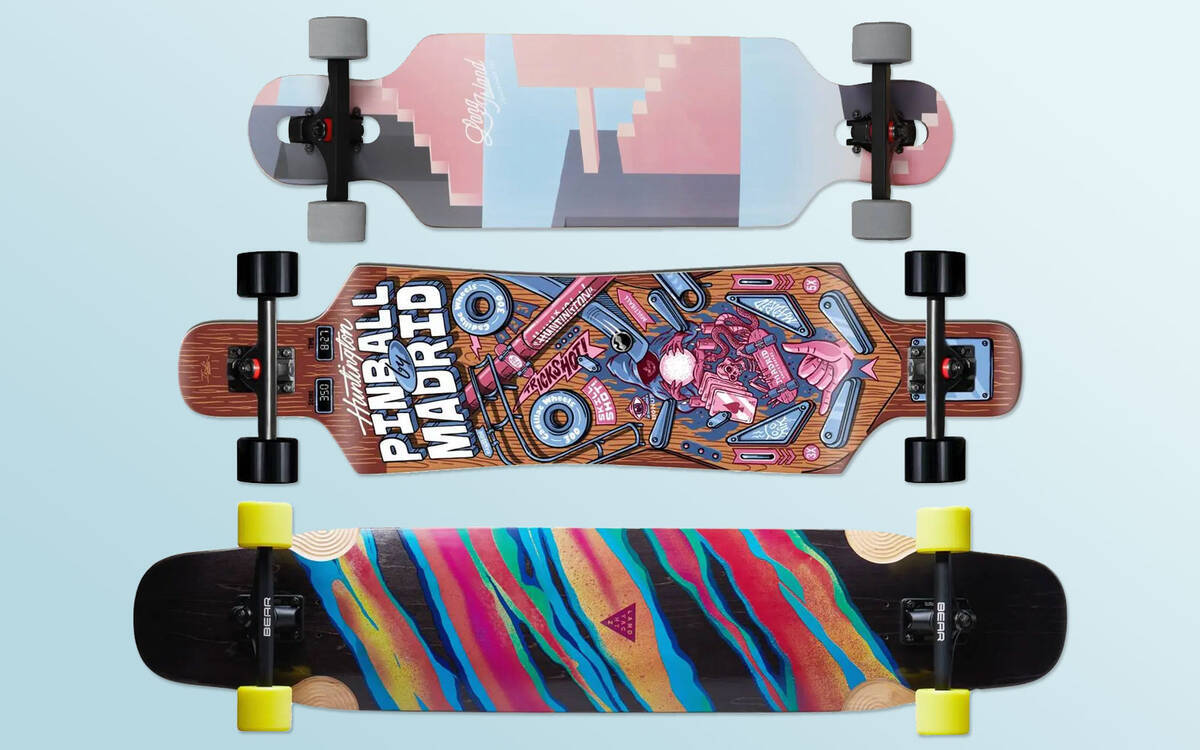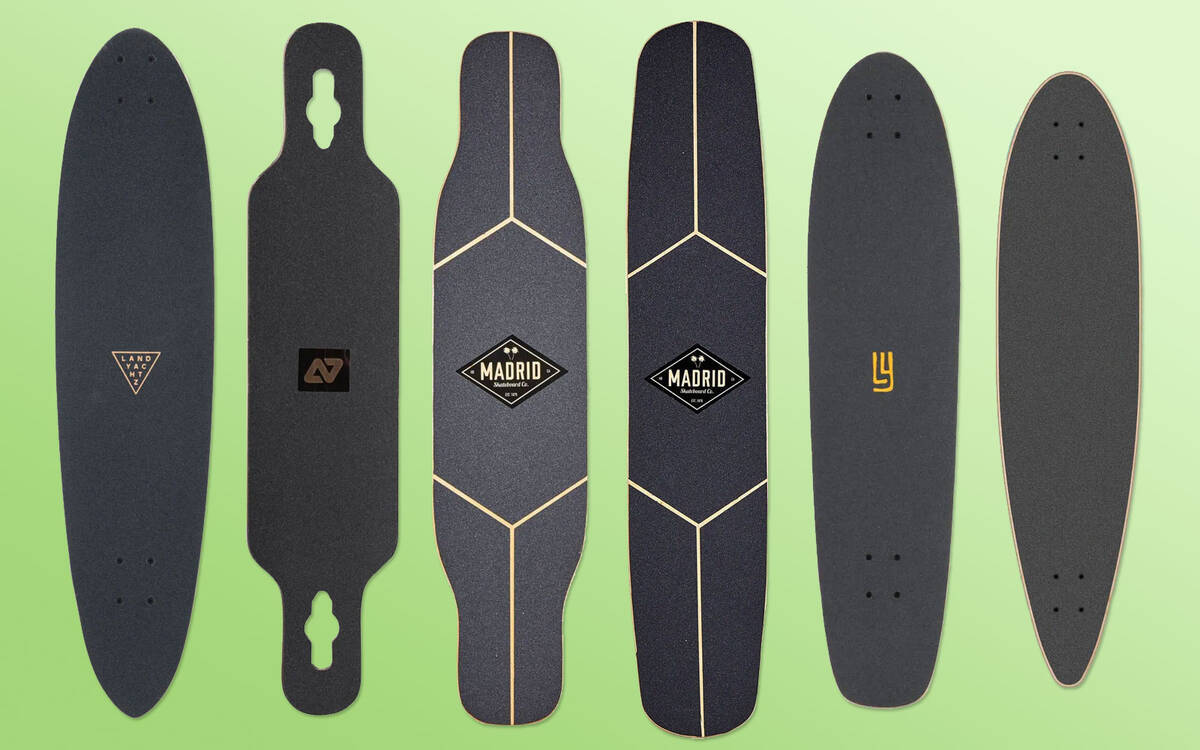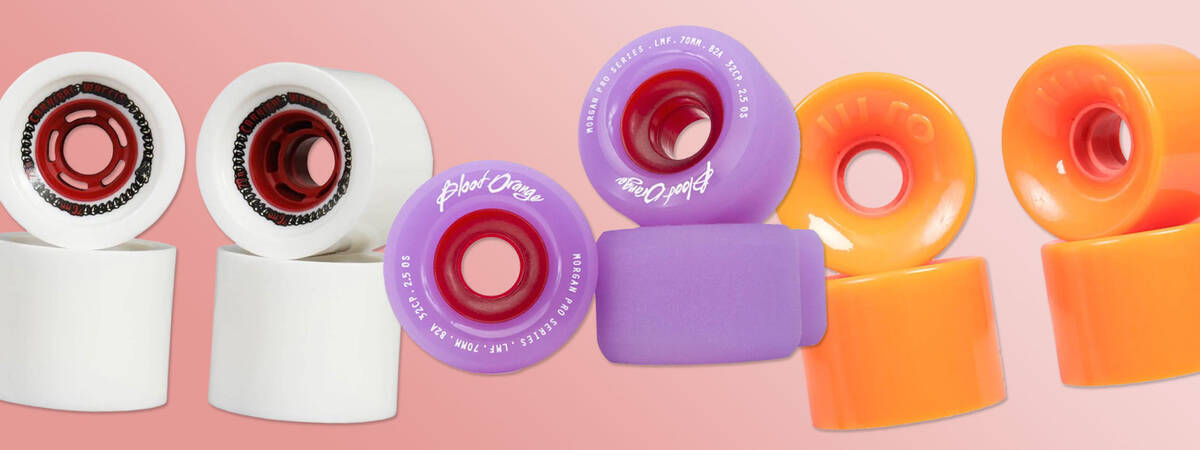Longboard Purchasing Manual - Selecting the Ideal Longboard for You
Whether you require a complete longboard aimed at beginners or you've been longboarding for some time and want to enhance your setup, this guide provides all the essential information about longboards!
It's not compulsory to peruse this guide from beginning to end (you're probably more eager for longboards than a lengthy read). Indeed, we supply ample details on our product pages to aid in your longboard selection. Feel free to proceed to our assortment of complete longboards.
For those who have particular interests regarding longboarding equipment, you can swiftly move to the section that most appeals to you by selecting from the content list below:
Overview
Overview
Varieties of Longboards - What Kind of Longboard is Best for Me?
Longboards are crafted for diverse styles of riding. When opting for a complete longboard, having a foundational knowledge of longboards and longboarding styles is beneficial.
Choosing a longboard over a skateboard likely means you're seeking a smooth cruise and/or are fascinated by a performance-based discipline like longboard dancing or downhill longboarding.
The ideal longboard choice hinges on your favoured longboarding style. The upcoming sections will break down the key elements of various longboarding disciplines and the corresponding longboards. Continue to explore to learn more about the types of longboards. We've sorted them into six categories to streamline your selection of the best longboard for you!
Longboard Cruisers & Carving Longboards
Cruising and carving longboards often possess similar features. Cruising simply involves riding your longboard, whereas carving requires shifting from side to side to control speed, much like how a snowboarder carves down slopes.


Whether your inclination is towards cruising or carving, their complimentary characteristics mean a cruiser board with a pintail shape might fit your needs well. These cruiser decks, with their pintail shapes, offer excellent options for commuting or relaxed rides around your locality, focusing on stability and a seamless experience rather than tricks.
Beginner longboarders will find cruiser longboards to be a suitable choice, with carving being a potential progression from cruising.
Downhill Longboards & Freeride Longboards
Downhill longboards are designed for stability to avoid speed wobbles, requiring rigid decks and wide trucks. To safely achieve high speeds and counteract road imperfections or sudden slides, leading downhill longboards have large, broad, and soft wheels.

Freeride longboards, on the other hand, are more versatile compared to downhill designs. Primarily for rapid downhill stages, they prioritise manoeuvrability for technical slides. Though downhill boards focus on speed and stability, a commendable freeride board brings greater agility and control - particularly suited for sliding and carving.

It's critical to wear protective gear when engaging in freeride or downhill longboarding.
Freestyle Longboards
Freestyle longboards focus on technical skills and artistic tricks above speed. These boards are typically symmetrical with kicks on both ends, allowing for tricks and riding in either direction - hence the name bi-directional. Freestyle longboarding doesn’t emphasise speed or distance, so wheels are generally harder and smaller compared to other longboard styles.

The art of freestyle longboarding lies in creativity and extending the boundaries of what's achievable with a longboard. Those fond of skateboarding might find freestyle longboarding particularly appealing.
If you aim to perform tricks while occasionally cruising, freestyle longboarding could be the perfect fit for you.
Dancer Longboards
Dancer longboards are intended for individuals who revel in graceful and rhythmic movements on a longboard. These are crafted for longboard dancing, effortlessly merging fluid motions, intricate footwork, and expressive flair.
The finest dancer longboards feature symmetrical, bi-directional shapes and are in fact the longest among longboard types, providing ample room for extraordinary steps and having kicks at both ends.

A dancer's setup should be versatile, preferably with medium flex and responsive trucks, ensuring a balanced combination of stability and agility, ideal for executing complex footwork.
If you're enticed by the tempo of dance and the thrill of surpassing your limits, a dancer longboard is your perfect roadside companion, encouraging creativity as you glide to beat of the pavement. Embrace the tempo, unleash your creativity, and express yourself freely with a dancer longboard.
Navigate to our selection of complete longboards where filtering by riding style is possible.
Determining the Right Longboard Size for You

Your optimal longboard size is largely dictated by your riding style. While skateboarders often consider shoe size for deck width, longboarders focus more on their riding preferences than physical attributes. For example, downhill riding generally requires shorter decks than those used for longboard dancing. Thus, prioritise your riding style over height or shoe size when selecting a longboard size.
Shortboards might suit riders with small feet, while taller individuals with larger feet might prefer a longer version of the same type of deck. The key is finding the right harmony between your body proportions and riding style.
Longboard Wheelbase

The wheelbase on a longboard is the span between the front and rear wheels. Although the deck length hints at wheelbase, it's not a direct measurement since design features like kick tails can add deck length without influencing the wheelbase.
A longer wheelbase contributes to slower turns and a more stable ride, making it easier to control during slides but less agile.
- Longer wheelbase: Fosters a more stable setup with slower turns, facilitating control during slides but sacrificing agility.
- Shorter wheelbase: Offers increased agility but decreased stability due to a more acute turning radius.
It's noteworthy that some decks have adjustable wheelbases, with multiple holes allowing for variation in truck placement.
Different Shapes of Longboard Decks

Recognising the variations between different longboard deck shapes and features aids in your decision on which deck best suits your riding style. Understanding how specific shapes and features impact your riding is crucial for making educated choices.
Pintail Longboards
Pintails are typically associated with surf-style cruiser longboards. Named for their resemblance to the tail of pintail ducks, pintail boards often resemble surfboards. These shapes might not suit freestyle longboarding but are enjoyable for those desiring a nimble board for street cruising and carving.
Drop Down Longboards
Drop-down decks possess a lower platform between the trucks, which reduces the centre of gravity. This closeness to the ground provides numerous benefits for beginners; requiring less effort for pushing and increasing predictability during turns. With a natural extension of the wheelbase, drop-down decks facilitate sliding with more ease.
Drop-down longboard decks, ideal for beginners and those who enjoy cruising, carving, or freeriding, should however be avoided for high-speed downhill pursuits.
Double Drop Longboards
Combining a dropped platform and drop-through truck mounting, double drop decks achieve a very low centre of gravity, offering remarkable stability that's beneficial for pushing and sliding.
For those prioritising proximity to the ground, double drop decks excel in stability for cruising, freeriding and sliding, making them an excellent option for both novices seeking reliability and advanced riders desiring outstanding sliding capabilities.
Wheel Wells on Longboards
Some longboards have wheel wells - concave cuts near the wheels providing clearance during sharp turns, greatly reducing wheel bites.
Longboard Cutouts
Cutouts are areas carved out of the deck allowing larger wheels with no wheel bite risk, as no deck material sits above the wheels.
Longboard Kicks & Double Kick Decks
These end-of-deck raised sections, particularly found on dancer and freestyle boards, allow for execution of moves like ollies and kickturns. Double kicks are crucial for dancer and freestyle setups.
Drop-Through Longboards
Drop-through longboards have a design where the trucks mount through the deck, lowering the ride height and centre of gravity, boosting stability for cruising, freeriding, commuting, and carving while reducing fatigue.
The drop-through construction sees the trucks' baseplates integrated into the deck's top, necessitating separation of the hanger from the baseplate for mounting.
Select trucks suited for drop-through decks by preferring real Reverse Kingpin (RKP) Longboard Trucks over standard skateboard trucks for best performance.
Drop Through vs. Top Mount Longboard


Distinguishing between top mount and drop-through setups is vital, given the significant riding experience impact they have.
Top-mounting involves fixing the trucks right beneath the deck, which is then seated on top of the trucks. This arrangement offers enhanced leverage and responsiveness, ideal for carving, freestyle riding, and maximum manoeuvrability.
Conversely, drop-through mounting requires securing the trucks through deck cutouts, allowing them to extend below the deck's surface. This lowers the centre of gravity, thereby increasing stability and easing the pushing action, as the foot is nearer to the ground. It also aids in sliding.
Drop-through longboards have cutouts positioned near the wheels for wheel clearance—essential due to the deck's lowered stance. These cutouts on drop-through decks prevent wheel bites and enable smoother turns and movements by facilitating flush fitting of the wheels with the deck's underside.
Your choice between drop-through and top-mount configurations depends on your style and preferences in riding. A drop-through deck is more appropriate if you prioritise stability and speed. However, if your emphasis is on manoeuvrability and responsiveness, a top-mount deck should be your go-to.
When exploring our range of longboard decks, drop-through decks can be identified by their sizeable truck mounting holes.
Longboard Trucks Overview

The optimal longboard trucks are those that best match your riding style. Truck features significantly influence your setup's traits. Important specifications to evaluate include kingpin orientation, baseplate angle, and hanger width.
Reverse Kingpin vs Traditional Kingpin Trucks
You will frequently see RKP and TKP abbreviations, signifying the primary differences in kingpin placements on longboard trucks. Here's what they mean:
- Reverse kingpin trucks (RKP), often termed longboard trucks, shine in the longboarding realm, though not ordinarily used for skateboards. With RKP trucks, the kingpin angles away from the setup's centre, offering stability along with smooth, agile turns. Notably, an RKP truck sits higher than a TKP truck.
- Traditional kingpin trucks (TKP)—also known as classic or vertical kingpin trucks—are mainly linked with skateboarding, seldom used for longboarding. TKP trucks, featuring a lower kingpin than the hanger, are particularly favourable for grinding.
Deciding between RKP and TKP trucks ultimately comes down to their turning properties. Reverse kingpin trucks are prized for their controllability at high speeds, noted for predictability when turning at high velocities compared to traditional kingpin trucks.
Baseplate Angle in Longboard Trucks

Baseplate angle on longboard trucks signifies the angle between a line parallel to the baseplate and a line running from the pivot cup toward the hanger.
This angle greatly affects your longboard's overall characteristics:
- Smaller baseplate angle: Larger turning radius, requiring greater deck lean for turns, enhancing stability and minimizing wobbles at high speeds. Opting for a lower baseplate angle raises your setup's stability.
- Larger baseplate angle: Results in a more nimble truck with a smaller turning radius, facilitating easier, more efficient turns. A larger baseplate angle is particularly beneficial for beginners mastering basic skills like pushing and turning.
Filter our longboard truck selection by baseplate angle to find what suits you best.
Longboard Bushings Essentials

Longboard bushings, doughnut-shaped components made from polyurethane, reside inside the truck's hanger, affecting the board's stability and responsiveness. Available in various shapes, sizes, and hardness levels (durometer), bushings can be tailored for your preferred board feel and performance.
Bushing hardness:
- Softer bushings: Increase turn ability and carving ability.
- Harder bushings: Offer greater stability at higher speeds.
Bushing shapes:
- Cone bushings: Found in both short and long varieties, renowned for responsiveness, ideal for cruising and carving setups.
- Barrel bushings: Enhance truck stability, less prone to turning.
- Eliminator bushings: Remove any unwanted truck movement. Favourable for those seeking stable, high-speed setups or requiring extra bushing support. They fill the entire bushing seat and overlap bushing edges, offering control even with softer bushings.
Swapping bushings can notably alter your setup's dynamics, so consider these when adjusting its characteristics.
Longboard Truck Dimensions & Width Considerations
Trucks should be in line width-wise with your deck at its broadest point to prevent issues like wheel strikes during pushing.
For determining the appropriate truck width for your deck, we advise measuring axle width, which specifies truck total width, rather than hanger width. At SkatePro, we make it straightforward by listing axle width among truck specifications.
- Narrower longboard trucks: More reactive and agile.
- Wider longboard trucks: Offer superior stability, simplifying control at speeds.
Find everything needed for your longboard trucks, including risers, parts, and bushings:
Guide to Longboard Wheels

Identifying the best longboard wheels is a key focus for longboarders. Not only do wheels greatly influence setup characteristics, but their vibrant hues and designs often result in a fetishism towards longboard wheel commodities.
Let's exchange a focus on aesthetics for essential details regarding how wheel specifications affect your riding experience.
Most longboard wheels are crafted from polyurethane, a flexible plastic produced in multiple variations. Different wheel manufacturers use proprietary formulas, crafting wheels with distinct traits to elevate the ride experience.
The wheel size, hardness, and shape are primary considerations when selecting longboard wheels.
Understanding Longboard Wheel Size
Grasp how size impacts speed, momentum, ride quality, and manoeuvrability for optimal wheel selection:
Speed and momentum:
- Larger wheels: Achieve higher top speeds, better speed retention.
- Smaller wheels: Lower top speeds, but faster acceleration.
Ride quality:
- Larger wheels: Smoother rides due to expansive surface and gentler curvature absorbing irregularities.
- Smaller wheels: More abrupt encounters with ground inconsistencies, heightening stop risks from cracks or minor debris.
Manoeuvrability:
- Larger wheels: Offer stability at the expense of manoeuvrability.
- Smaller wheels: Heightened manoeuvrability and agility.
Weight:
- Larger wheels: Heavier than their smaller counterparts.
Sliding ability:
- Larger wheels: More challenging to initiate slides and control post-slide commencement.
- Smaller wheels: Easier slide initiation and control.
By selecting a fitting wheel size for your longboard, you'll address these considerations. Vital setup compatibility—especially avoiding wheel biting—is crucial. If concerned, consider risers as a precaution:
Grasping Longboard Wheel Hardness
Longboard wheel hardness measures using the durometer scale, applicable to all skate wheels. A higher durometer score denotes harder wheels. Considering wheel hardness is vital when picking new longboard wheels—or a complete longboard with pre-fitted wheels—so remember the durometer rating.
Here's a quick comparison of hard versus soft longboard wheels:
- Harder longboard wheels: Less gripping, facilitate sliding, absorb vibrations poorly.
- Softer longboard wheels: More gripping, harder to slide, absorb vibrations better.
Typically ranging between 78A to 85A, longboard wheels are relatively soft, ensuring smooth rides on rough terrains at high speeds.
Longboard Wheel Width & Shape
Width and shape determine the contact patch—where wheels meet ground—of longboard wheels.
- Wider contact patch: Increased grip.
- Narrower contact patch: Reduced grip, easing slides.
Edges, or lips, further influence the wheel's performance by defining the contact patch. Wheels with sharp edges provide a broader contact patch than those with rounded or bevelled edges.
- Wheels with sharp edges offer wider contact patches, delivering grip and stability during fast rides.
- Wheels with bevelled or rounded edges have narrow contact patches, promoting easier slides and lighter weight. Consequently, they enhance agility and manoeuvrability.
Selecting the Optimum Longboard Wheels
Considering key factors—size, hardness, and shape—guides identifying the optimal wheels for your setup. However, practical application may differ from theoretical expectations, prompting experimentation with various wheels until you cease longboarding.
Here are frequently asked questions regarding specific longboard wheels:
Ideal Wheels for Longboard Sliding?
Choosing slide-oriented longboard wheels involves selecting smaller wheels at the harder durometer range (up to 85A), with narrow contact patches (bevelled or rounded edges).
Selecting the Best Longboard Wheels for Cruising?
When cruising, give priority to wheels that roll smoothly and effectively absorb vibrations on rough surfaces. Choose softer wheels (74A - 78A) with a relatively large diameter (65 - 70 mm). For maximum grip, select wheels with sharp edges; for greater agility and a smoother ride, consider models with rounded or bevelled lips. This will provide you with ideal wheels for cruising or commuting.
Guidelines for Selecting Optimal Longboard Wheels for Dance and Freestyle
For dancing moves and tricks, focus on wheels that offer easy control and are lightweight. Within the realm of longboard dancing and freestyle, agility and manoeuvrability are more important than speed and stability. Choose wheels with a diameter of approximately 65 mm, along with rounded or bevelled edges, and a soft durometer rating.
